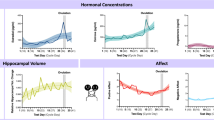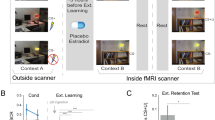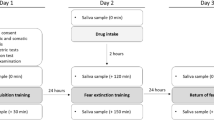Abstract
Estrogens are known to exert significant structural and functional effects in the hippocampus of adult rodents. In particular, 17β-estradiol can improve, impair, or have no effect on hippocampus-dependent learning and memory depending on dose and time of administration. The effects of other forms of estrogen, such as estrone and 17α-estradiol, on hippocampus-dependent learning have not been as thoroughly investigated. Therefore, the purpose of this study was to investigate the effects of 17β-estradiol, estrone, and 17α-estradiol at three different doses on two different tasks: hippocampus-dependent contextual fear conditioning and hippocampus-independent cued fear conditioning. Adult ovariectomized female rats were injected with one of the estrogens at one of the three doses 30 mins before conditioning to assess the rapid effects of these estrogens on acquisition. Twenty-four hours later memory for the context was examined and 1 h later memory for the cue (tone) was assessed. Levels of synaptophysin were examined in the dorsal hippocampus of rats to identify a potential synaptic correlate of hormonal effects on contextual fear conditioning. Low 17β-estradiol and 17α-estradiol enhanced, whereas high 17β-estradiol and 17α-estradiol impaired, contextual fear conditioning. Only the middle dose of estrone severely impaired contextual fear conditioning. Estrogens did not alter performance in the hippocampus-independent cued task. Synaptophysin expression was increased by estrone (at a middle and high dose) and 17β-estradiol (at a middle dose) in the CA3 region of the hippocampus and was not correlated with cognition. The results of this study indicate that estradiol can positively or negatively influence hippocampus-dependent learning and memory, whereas estrone impairs hippocampus-dependent learning and memory in a dose-dependent manner. These results have important therapeutic implications, as estrone, a main component of a widely used hormone replacement therapy, was shown to have either a negative effect or no effect on learning and memory. It may be possible to use 17α-estradiol and lower doses of estrogens as potential alternatives in hormone replacement therapies.
Similar content being viewed by others
Log in or create a free account to read this content
Gain free access to this article, as well as selected content from this journal and more on nature.com
or
References
Acosta JI, Mayer L, Talboom JS, Zay C, Scheldrup M, Castillo J et al (2009). Premarin improves memory, prevents scopolamine-induced amnesia and increases number of basal forebrain choline acetyltransferase positive cells in middle-aged surgically menopausal rats. Horm Behav 55: 454–464.
Altemus M, Conrad CD, Dolan S, McEwen BS (1998). Estrogen reduces fear conditioning: differential effects on tone vs contextual conditioning. Biol Psychiatr 43: 14S.
Barha CK, Lieblich SE, Galea LA (2009). Different forms of oestrogen rapidly upregulate cell proliferation in the dentate gyrus of adult female rats. J Neuroendocrinol 21: 155–166.
Barrientos RM, O'Reilly RC, Rudy JW (2002). Memory for context is impaired by injecting anisomycin into dorsal hippocampus following context exploration. Behav Brain Res 134: 299–306.
Berry B, McMahan R, Gallagher M (1997). Spatial learning and memory at defined points of the estrous cycle: effects of performance on a hippocampal-dependent task. Behav Neurosci 111: 267–274.
Bimonte HA, Denenberg VH (1999). Estradiol facilitates performance as working memory load increases. Psychoneuroendocrinology 24: 161–173.
Brake WG, Alves SE, Dunlop JC, Lee SJ, Bulloch K, Allen PB et al (2001). Novel target sites for estrogen action in the dorsal hippocampus: an examination of synaptic proteins. Endocrinology 142: 1284–1289.
Burton CL, Chatterjee D, Chatterjee-Chakraborty M, Lovic V, Grella SL, Steiner M et al (2007). Prenatal restraint stress and motherless rearing disrupts expression of plasticity markers and stress-induced corticosterone release in adult female Sprague-Dawley rats. Brain Res 1158: 28–38.
Cravens CJ, Vargas-Pinto N, Christian KM, Nakazawa K (2006). CA3 NMDA receptors are crucial for rapid and automatic representation of context memory. Eur J Neurosci 24: 1771–1780.
Daniel JM, Fader AJ, Spencer AL, Dohanich GP (1997). Estrogen enhances performance of female rats during acquisition of a radial arm maze task. Horm Behav 32: 217–225.
Daniel JM (2006). Effects of oestrogen on cognition: what have we learned from basic research? J Neuroendocrinol 18: 787–795.
Fader AJ, Johnson PE, Dohanich GP (1999). Estrogen improves working but not reference memory and prevents amnestic effects of scopolamine of radial-arm maze. Pharmacol Biochem Behav 62: 711–717.
Farr SA, Banks WA, Morley JE (2000). Estradiol potentiates acetylcholine and glutamate-mediated post-trial memory processing in the hippocampus. Brain Res 864: 263–269.
Floresco SB, Magyar O (2006). Mesocortical dopamine modulation of executive functions: beyond working memory. Psychopharmacology (Berl) 188: 567–585.
Frick KM, Fernandez SM, Bulinski SC (2002). Estrogen replacement improves spatial reference memory and increases hippocampal synaptophysin in aged female mice. Neuroscience 115: 547–558.
Frick KM, Fernandez SM, Bennett JC, Prange-Kiel J, MacLusky NJ, Leranth C (2004). Behavioral training interferes with the ability of gonadal hormones to increase CA1 spine synapse density in ovariectomized female rats. Eur J Neurosci 19: 3026–3032.
Frick KM (2009). Estrogens and age-related memory decline in rodents: what have we learned and where do we go from here? Horm Behav 55: 2–23.
Frye CA (1995). Estrus-associated decrements in a water maze task are limited to acquisition. Physiol Behav 57: 5–14.
Frye CA, Walf AA (2004). Estrogen and/or progesterone administered systemically or to the amygdala can have anxiety-, fear-, and pain-reducing effects in ovariectomized rats. Behav Neurosci 118: 306–313.
Galea LA, Wide JK, Paine TA, Holmes MM, Ormerod BK, Floresco SB (2001). High levels of estradiol disrupt conditioned place preference learning, stimulus response learning and reference memory but have limited effects on working memory. Behav Brain Res 126: 115–126.
Gao Y, Bezchlibnyk YB, Sun X, Wang JF, McEwen BS, Young LT (2006). Effects of restraint stress on the expression of proteins involved in synaptic vesicle exocytosis in the hippocampus. Neuroscience 141: 1139–1148.
Gupta RR, Sen S, Diepenhorst LL, Rudick CN, Maren S (2001). Estrogen modulates sexually dimorphic contextual fear conditioning and hippocampal long-term potentiation (LTP) in rats. Brain Res 888: 356–365.
Holmes MM, Wide JK, Galea LA (2002). Low levels of estradiol facilitate, whereas high levels of estradiol impair, working memory performance on the radial arm maze. Behav Neurosci 116: 928–934.
Jin M, Jin F, Zhang L, Chen Z, Huang H (2005). Two estrogen replacement therapies differentially regulate expression of estrogen receptors alpha and beta in the hippocampus and cortex of ovariectomized rat. Brain Res Mol Brain Res 142: 107–114.
Joels M (2007). Role of corticosteroid hormones in the dentate gyrus. Prog Brain Res 163: 355–370.
Kim JJ, Fanselow MS (1992). Modality-specific retrograde amnesia of fear. Science 256: 675–677.
Korol DL, Malin EL, Borden KA, Busby RA, Couper-Leo J (2004). Shifts in preferred learning strategy across the estrous cycle in female rats. Horm Behav 45: 330–338.
Kubik S, Miyashita T, Guzowski JF (2007). Using immediate-early genes to map hippocampal subregional functions. Learn Mem 14: 758–770.
Kudwa AE, Michopoulos V, Gatewood JD, Rissman EF (2006). Roles of estrogen receptors alpha and beta in differentiation of mouse sexual behavior. Neuroscience 138: 921–928.
Lee I, Kesner RP (2004). Differential contributions of dorsal hippocampal subregions to memory acquisition and retrieval in contextual fear-conditioning. Hippocampus 14: 301–310.
Leuner B, Mendolia-Loffredo S, Shors TJ (2004). High levels of estrogen enhance associative memory formation in ovariectomized females. Psychoneuroendocrinology 29: 883–890.
Luine V, Rodriguez M (1994). Effects of estradiol on radial arm maze performance of young and aged rats. Behav Neural Biol 62: 230–236.
Luine VN, Richards ST, Wu VY, Beck KD (1998). Estradiol enhances learning and memory in a spatial memory task and effects levels of monoaminergic neurotransmitters. Horm Behav 34: 149–162.
Luine VN, Jacome LF, MacLusky NJ (2003). Rapid enhancement of visual and place memory by estrogens in rats. Endocrinology 144: 2836–2844.
Luine VN (2008). Sex steroids and cognitive function. J Neuroendocrinol 20: 866–872.
MacLusky NJ, Luine VN, Hajszan T, Leranth C (2005). The 17alpha and 17beta isomers of estradiol both induce rapid spine synapse formation in the CA1 hippocampal subfield of ovariectomized female rats. Endocrinology 146: 287–293.
Maren S (1998). Overtraining does not mitigate contextual fear conditioning deficits produced by neurotoxic lesions of the basolateral amygdala. J Neurosci 18: 3088–3097.
Maren S (2008). Pavlovian fear conditioning as a behavioral assay for hippocampus and amygdala function: cautions and caveats. Eur J Neurosci 28: 1661–1666.
Markus EJ, Zecevic M (1997). Sex differences and estrous cycle changes in hippocampus-dependent fear conditioning. Psychobiology 25: 246–252.
Martel C, Rheaume E, Takahashi M, Trudel C, Couet J, Luu-The V et al (1992). Distribution of 17 beta-hydroxysteriod dehydrogenase gene expression and activity in rat and human tissue. J Steriod Biochem Mol Biol 41: 597–603.
Milad MR, Goldstein JM, Orr SP, Wedig MM, Klibanski A, Pitman RK et al (2006). Fear conditioning and extinction: influence of sex and menstrual cycle in healthy humans. Behav Neurosci 120: 1196–1203.
Miranda P, Williams CL, Einstein G (1999). Granule cells in aging rats are sexually dimorphic in their response to estradiol. J Neurosci 19: 3316–3325.
Murphy DD, Segal M (1996). Regulation of dendritic spine density in cultured rat hippocampal neurons by steroid hormones. J Neurosci 16: 4059–4068.
Ormerod BK, Lee TT, Galea LA (2003). Estradiol initially enhances but subsequently suppresses (via adrenal steroids) granule cell proliferation in the dentate gyrus of adult female rats. J Neurobiol 55: 247–260.
Osterlund M, Kuiper GG, Gustafsson JA, Hurd YL (1998). Differential distribution and regulation of estrogen receptor-alpha and -beta mRNA within the female rat brain. Brain Res Mol Brain Res 54: 175–180.
Perez E, Liu R, Yang SH, Cai ZY, Covey DF, Simpkins JW (2005). Neuroprotective effects of an estratriene analog are estrogen receptor independent in vitro and in vivo. Brain Res 1038: 216–222.
Phillips RG, LeDoux JE (1992). Differential contribution of amygdala and hippocampus to cued and contextual fear conditioning. Behav Neurosci 106: 274–285.
Pozzo-Miller LD, Inoue T, Murphy DD (1999). Estradiol increases spine density and NMDA-dependent Ca2+ transients in spines of CA1 pyramidal neurons from hippocampal slices. J Neurophysiol 81: 1404–1411.
Rajji T, Chapman D, Eichenbaum H, Greene R (2006). The role of CA3 hippocampal NMDA receptors in paired associate learning. J Neurosci 26: 908–915.
Rannevik G, Jeppsson S, Johnell O, Bjerre B, Laurell-Borulf Y, Svanberg L (1995). A longitudinal study of the perimenopausal transition: altered profiles of steroid and pituitary hormones, SHBG and bone mineral density. Maturitas 21: 103–113.
Rhodes ME, Frye CA (2006). ERbeta-selective SERMs produce mnemonic-enhancing effects in the inhibitory avoidance and water maze tasks. Neurobiol Learn Mem 85: 183–191.
Rune GM, Wehrenberg U, Prange-Kiel J, Zhou L, Adelmann G, Frotscher M (2002). Estrogen up-regulates estrogen receptor alpha and synaptophysin in slice cultures of rat hippocampus. Neuroscience 113: 167–175.
Ryan J, Scali J, Carriere I, Ritchie K, Ancelin ML (2008). Hormonal treatment, mild cognitive impairment and Alzheimer's disease. Int Psychogeriatr 20: 47–56.
Schiess MC, Joels M, Shinnick-Gallagher P (1988). Estrogen priming affects active membrane properties of medial amygdala neurons. Brain Res 440: 380–385.
Shaikh AA (1971). Estrone and estradiol levels in the ovarian venous blood from rats during the estrous cycle and pregnancy. Biol Reprod 5: 297–307.
Sharma K, Mehra RD, Dhar P, Vij U (2007). Chronic exposure to estrogen and tamoxifen regulates synaptophysin and phosphorylated cAMP response element-binding (CREB) protein expression in CA1 of ovariectomized rat hippocampus. Brain Res 1132: 10–19.
Shughrue PJ, Lane MV, Merchenthaler I (1997). Comparative distribution of estrogen receptor-alpha and -beta mRNA in the rat central nervous system. J Comp Neurol 388: 507–525.
Stone DJ, Rozovsky I, Morgan TE, Anderson CP, Finch CE (1998). Increased synaptic sprouting in response to estrogen via an apolipoprotein E-dependent mechanism: implications for Alzheimer's disease. J Neurosci 18: 3180–3185.
Tanapat P, Hastings NB, Reeves AJ, Gould E (1999). Estrogen stimulates a transient increase in the number of new neurons in the dentate gyrus of the adult female rat. J Neurosci 19: 5792–5801.
Tanapat P, Hastings NB, Gould E (2005). Ovarian steroids influence cell proliferation in the dentate gyrus of the adult female rat in a dose- and time-dependent manner. J Comp Neurol 481: 252–265.
Toran-Allerand CD, Guan X, MacLusky NJ, Horvath TL, Diano S, Singh M et al (2002). ER-X: a novel, plasma membrane-associated, putative estrogen receptor that is regulated during development and after ischemic brain injury. J Neurosci 22: 8391–8401.
Toran-Allerand DC, Tinnikov AA, Singh RJ, Nethrapalli IS (2005). 17α-estradiol: a brain-active estrogen? Endocrinology 146: 3843–3850.
Viau V, Meaney MJ (1991). Variations in the hypothalamic-pituitary-adrenal response to stress during the estrous cycle in the rat. Endocrinology 129: 2503–2511.
Warren SG, Juraska JM (1997). Spatial and nonspatial learning across the rat estrous cycle. Behav Neurosci 111: 259–266.
Wilson IA, Puolivali J, Heikkinen T, Riekkinen Jr P (1999). Estrogen and NMDA receptor antagonism: effects upon reference and working memory. Eur J Pharmacol 381: 93–99.
Winocur G, Wojtowicz JM, Sekeres M, Snyder JS, Wang S (2006). Inhibition of neurogenesis interferes with hippocampus-dependent memory function. Hippocampus 16: 296–304.
Womble MD, Andrew JA, Crook JJ (2002). 17beta-estradiol reduces excitatory postsynaptic potential (EPSP) amplitude in rat basolateral amygdala neurons. Neurosci Lett 331: 83–86.
Woolley CS, Gould E, Frankfurt M, McEwen BS (1990). Naturally occurring fluctuation in dendritic spine density on adult hippocampal pyramidal neurons. J Neurosci 10: 4035–4039.
Woolley CS, McEwen BS (1992). Estradiol mediates fluctuation in hippocampal synapse density during the estrous cycle in the adult rat. J Neurosci 12: 2549–2554.
Woolley CS, McEwen B (1993). Roles of estradiol and progesterone in regulation of hippocampal dendritic spine density during the estrous cycle in the rat. J Comp Neurol 336: 293–306.
Acknowledgements
We thank the laboratory of Dr Alison Fleming for their generous sharing of the synaptophysin protocol and Dr Stan Floresco for his assistance with this work. We also thank Morgan Martin, Jonathan Epp, and Stephanie Lieblich for their help in this work. This research was funded by Pacific Alzheimer Research Foundation and NSERC operating grants to LAMG. CKB was funded by a PGS-D from NSERC and is a Pacific Century Scholar. LAMG is a Michael Smith Senior Scholar.
Author information
Authors and Affiliations
Corresponding author
Additional information
DISCLOSURE
The authors declare no conflict of interest.
Rights and permissions
About this article
Cite this article
Barha, C., Dalton, G. & Galea, L. Low Doses of 17α-Estradiol and 17β-Estradiol Facilitate, Whereas Higher Doses of Estrone and 17α- and 17β-Estradiol Impair, Contextual Fear Conditioning in Adult Female Rats. Neuropsychopharmacol 35, 547–559 (2010). https://doi.org/10.1038/npp.2009.161
Received:
Revised:
Accepted:
Published:
Issue date:
DOI: https://doi.org/10.1038/npp.2009.161
Keywords
This article is cited by
-
Mixed effects of perfluoroalkyl and polyfluoroalkyl substances exposure on cognitive function among people over 60 years old from NHANES
Environmental Science and Pollution Research (2022)
-
Oestradiol as a neuromodulator of learning and memory
Nature Reviews Neuroscience (2020)
-
Structural plasticity of the hippocampus in response to estrogens in female rodents
Molecular Brain (2019)
-
Reproductive experience alters the involvement of N-methyl-D-aspartate receptors in fear extinction, but not fear conditioning, in female Sprague Dawley rats
Psychopharmacology (2019)
-
On the role of brain aromatase in females: why are estrogens produced locally when they are available systemically?
Journal of Comparative Physiology A (2018)



